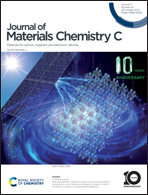Long-term spontaneous negative aging behavior of encapsulated blue quantum dot light emitting devices: the influence of the hole transport material†
Abstract
Encapsulated quantum dot light emitting devices (QLEDs) commonly exhibit a positive aging behavior, i.e., a spontaneous gradual improvement in their efficiency and performance during the first 10's of hours after encapsulation. In the long term, however, the trend reverses and the devices exhibit a spontaneous gradual deterioration in efficiency, a behavior referred to as negative aging. The root causes of this negative aging – which occurs without any electrical bias and therefore seriously limits the shelf life of QLEDs – remain unclear. Here, we carried out an in-depth analysis of the root causes behind the long-term spontaneous negative aging of encapsulated blue QLEDs. It is revealed that the long-term spontaneous negative aging is mainly due to the degradation of poly[(9,9-dioctylfluorenyl-2,7-diyl)-alt-(4,4′-(N-(4-butylphenyl))-diphenylamine)] (TFB), the most commonly used hole transport layer (HTL) material. Replacing TFB with 9,9-bis[4-[(4-ethenylphenyl)methoxy]phenyl]-N2,N7-di-1-naphthalenyl-N2,N7-diphenyl-9H-fluorene-2,7-diamine (VB-FNPD), a material that forms a cross-linked polymer, allows for preventing this negative aging behavior and maintaining the efficiency of the devices for over two months. This work provides design principles to realize long shelf-life QLEDs, and presents a new starting point for both fundamental studies and technological innovation.

- This article is part of the themed collection: Celebrating International Women’s day 2024: Women in Materials Science


 Please wait while we load your content...
Please wait while we load your content...